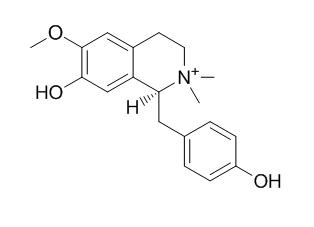Magnocurarine
Magnocurarine is a natural product from Magnolia officinalis.
Inquire / Order:
manager@chemfaces.com
Technical Inquiries:
service@chemfaces.com
Tel:
+86-27-84237783
Fax:
+86-27-84254680
Address:
1 Building, No. 83, CheCheng Rd., Wuhan Economic and Technological Development Zone, Wuhan, Hubei 430056, PRC
Providing storage is as stated on the product vial and the vial is kept tightly sealed, the product can be stored for up to
24 months(2-8C).
Wherever possible, you should prepare and use solutions on the same day. However, if you need to make up stock solutions in advance, we recommend that you store the solution as aliquots in tightly sealed vials at -20C. Generally, these will be useable for up to two weeks. Before use, and prior to opening the vial we recommend that you allow your product to equilibrate to room temperature for at least 1 hour.
Need more advice on solubility, usage and handling? Please email to: service@chemfaces.com
The packaging of the product may have turned upside down during transportation, resulting in the natural compounds adhering to the neck or cap of the vial. take the vial out of its packaging and gently shake to let the compounds fall to the bottom of the vial. for liquid products, centrifuge at 200-500 RPM to gather the liquid at the bottom of the vial. try to avoid loss or contamination during handling.
Journal of Functional Foods2024, 116:106186
Journal of Ginseng Research2022, j.jgr.2022.09.005.
Int J Mol Sci.2023, 24(24):17589.
J Ethnopharmacol.2017, 206:327-336
Mutlu Yanic S, Ates EG. JOTCSA.2023, 10(4);893-902.
Pharmacological Reports2020, 1-9
Molecules.2019, 24(24),4583
Phytomedicine.2023, 114:154813.
Bulletin of Health Research2016, 44(4):279-286
mBio.2020, 11(3):e00686-20.
Related and Featured Products
J Chromatogr Sci. 2016 Aug;54(7):1201-12.
Effect of Chemical Profiling Change of Processed Magnolia officinalis on the Pharmacokinetic Profiling of Honokiol and Magnolol in Rats.[Pubmed:
27107095 ]
METHODS AND RESULTS:
The stem of Magnoliae officinalis (MO) cortex is always preliminarily processed before being applied in traditional Chinese medicine. The definite bioavailability of honokiol (HO) and magnolol (MA) in processed MO (PMO) and the effect of chemical profiling change on the pharmacokinetics of HO and MA are always a greater challenge compared with those of MO. Compared with that of MO, the pharmacokinetic profiling of HO and MA in the PMO was significantly changed and the mean Tmax of HO and MA was increased by 31 and 50% (P < 0.05), respectively; the mean AUC0-t and Cmax of HO were increased by 36 and 24% (P < 0.05), respectively. Subsequently, the chemical profiling of MO and PMO was investigated by a simple and rapid LC-Q/TOF-MS coupled with multivariate analysis method. Principal component analysis and hierarchical cluster analysis of the chromatographic data demonstrated that the chemical profiling of PMO was significantly different from that of MO. Eight marker components including six alkaloids (Magnocurarine, magnoflorine, roemerine and three unidentified peaks) and two lignans (obovatol and MA) were screened out by partial least-squares discriminant analysis.
CONCLUSIONS:
The results indicated that the changes of eight marker components of PMO may have an effect on the pharmacokinetic profiles of HO and MA.
J Nat Prod. 2011 Nov 28;74(11):2425-30.
Alkaloids from the Chinese vine Gnetum montanum.[Pubmed:
22040053 ]
During a high-throughput screening campaign of a prefractionated natural product library, fractions from the Chinese vine Gnetum montanum showed in vitro activity against Pseudomonas aeruginosa wild-type strain, PAO1.
METHODS AND RESULTS:
UV-directed isolation of the organic extract from the vine leaves resulted in the purification of the new natural products N-methyllaudanosolinium trifluoroacetate (1), 3'-hydroxy-N,N-dimethylcoclaurinium trifluoroacetate (2), 1,9,10-trihydroxy-2-methoxy-6-methylaporphinium trifluoroacetate (3), and 6a,7-didehydro-1,9,10-trihydroxy-2-methoxy-6-methylaporphinium trifluoroacetate (4). Compound 4 is described here for the first time, and this is the first report of compounds 1-3 as natural products. Compounds 1-3 were found to racemize over time. Starting from commercially available (+)-boldine, through a series of semisynthetic reactions, a mechanism for the racemization of the isolated compounds is proposed.
CONCLUSIONS:
The known natural products (-)-latifolian A (5) and Magnocurarine (6) were also isolated during these studies. The antibacterial activity was explained by the presence of 5, which displayed an IC50 value of 9.8 μM (MIC = 35 μM).



